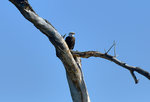
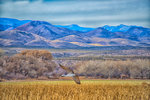
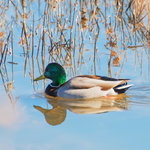


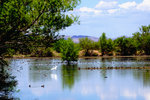
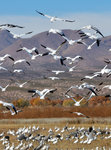
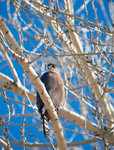
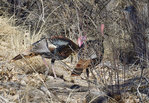
Perhaps most unique and memorable about the sandhill crane are its migratory flight sounds and its mating/bonding rituals.
“This charismatic bird continues to fascinate people in so many ways,” Bosque del Apache National Refuge Park Ranger Amanda Walker said. “For example, it is amazing how a bird like this, awkward on the ground, suddenly becomes graceful once it takes flight.”
Bosque del Apache is130 miles north of Las Cruces and 18 miles south of Socorro. Sandhill crane boosters maintain refuges throughout North America to preserve the species by combatting degradation of their habitats (www.savingscranes.org). It is sobering to realize that human activity threatens the survival of this most ancient of all currently living birds, which lineage to direct ancestors can be traced back to confirmed fossils formed at least 2.5 million years ago.
At Bosque del Apache thousands of sandhill cranes, ducks and geese stay from late October to late January, and then fly back north. Others remain only about two days before continuing their migration southward. By visiting the Bosque del Apache website anyone contemplating an in-person visit to the refuge during the pandemic can find updates about closing and re-openings of the visitor center, tour loops, and amenities like bathrooms, observation blinds and guided tours.
An auxiliary organization, The Friends of the Bosque del Apache,
raises money that supplements federal funding to maintain the refuge through such means as preserving and expanding sources of water and reducing the spread of invasive, non-indigenous species of plants.
The Friends’ live Festival of the Cranes has been cancelled because of the pandemic, and replaced by Crane Fiesta 2020, offered entirely online for this year.
While the Friends’ nature store onsite is closed, the online store continues to operate, now with even more products than before. Other key updates about the fiesta can be found at the Friends’ website.
One already scheduled event is a fly-out and fly-in of sandhill cranes that can be viewed on Nov. 19. Just before the crack of dawn, the cranes start communicating among themselves with a variety of distinctive sounds. For example, they gurgle, hiss, and honk and then fly off to the fields to feed, starting at sunrise. They return to their roosting grounds shortly before sunset.
Also, slides and videos, plus real-time Q & A, will be part of two webinars about cranes, which then will be archived.
Contributing a festive spirit are artists from the New Mexico Tech Performing Art Series, a stargazing party at the Magdalena Ridge Observatory about 50 miles from the refuge, and a craft demonstration involving the intertwining of yucca fibers to make sandals and the weaving of turkey feathers to create blankets.
The southern part of the state is part of the Rocky Mountain Flyway, the swath that is traversed by migrating sandhill cranes as they head due south, some even as far as northern Mexico. The cranes come from the northern states (including Alaska), Canada and even Siberia. Some cranes linger in the Mesilla Valley until their return trip to the north. In the spring, some of the northbound cranes choose instead the longer route that crosses the Platte River Valley in Nebraska, a route that avoids the Rocky Mountains, which, in many places, are still covered in snow.
Migrating sandhill cranes fly in the daytime. So, a sighting can be made. But their usual flight elevation of around 5,000 feet often makes it difficult to identify them, or see them altogether, especially when the cranes catch a warm upward draft to much greater heights in order to glide considerable distances. And they are difficult to spot also when small family groups break away from the flock. But their loud, always audible, rattling bugle calls dramatically announce their approach from as far as 2.5 miles away.
The sandhill crane breeds and begin raising young exclusively in the far north. So, in our region we are not treated to their famous mating rituals. A male tries to attract a female by various means, such as tossing pieces of vegetation into the air, pumping his head, leaping into the air, spreading and fluffing his wings, shaking his tail feathers. All the while, a female, if interested, exchanges calls with him. The effort is well worth it because if they end up bonding, it typically endures as long as both members of the pair live. The romance stays alive throughout the year over a lifetime with occasional cavorting and duets of calls, which can be observed at Bosque del Apache.
Julie-Anna Blomquist, who manages for The Friends auxiliary the celebrations of crane migration and the website in all seasons, is grateful for their partnership with the USFWS and City of Socorro.
“Visiting the refuge is a magical experience but maintaining this fragile oasis does not happen by magic,” she said.
Sources: “Sandhill Cranes’ Mating Dance a Stunning Spectacle,” by Sherry Boas Orlando Sentinel (Nov. 7, 2010); “Sandhill Crane,” National Geographic; “Sandhill Crane, Overview;” The Cornell Lab, All About Birds; “Fall Migration of the Cranes,” by Alyx Vogel, The Prairie Pulse (Oct. 10, 2018).